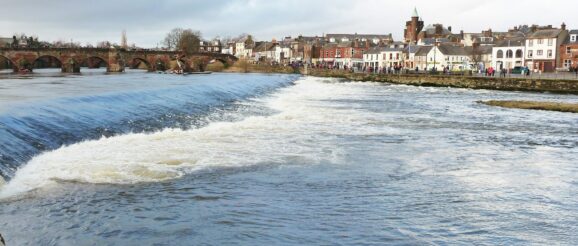Innovation in lockdown: a view from Dumfries – PAS

As part of our on-going series of blogs to find out how Covid-19 is impacting on our volunteers and the communities we support, we have a guest post from Tony Fitzpatrick in Dumfries. We are currently working with Tony on the Dumfries action plan project.
 Yes, even here in the deep south (of Scotland), we have been exercised by that whole “what are our town centres for” discussion. In fact, we maybe started the conversation sooner than some.
Yes, even here in the deep south (of Scotland), we have been exercised by that whole “what are our town centres for” discussion. In fact, we maybe started the conversation sooner than some.
Dumfries, population circa 33,000, is Dumfries and Galloway’s regional capital. It historically fulfilled roles as burgh market town, commercial/retail centre and once boasted a formidable manufacturing sector. As with many towns, these near-historic functions have morphed into a much more fragile and inter-dependent mix, trapped between the top-down roar of globalisation and the growing howl of the hyper-local.
It’s a familiar story. The slow contraction of big retail, the dampening of both public and disposable income, a 1980s town centre bypass, out-of-town plots to meet the needs of the ‘new’ shopper, pedestrianisation and stultifying business rentals and rates. All have all attracted their share of the blame.
Time then for a new Masterplan! That proposal caused something of a collective groan in the town. The last piece of council-commissioned work was back in the day when retail, cafes and more visitors were still seen as the ‘obvious’ solutions to the wilting high street. Little, however, was delivered as the 2008 crash, followed by sustained austerity and market failure, bit hard.
Some subtle shifts were however taking place. A poorly resourced local council, while understanding the need for some form of intervention, was less able to deliver change. The ‘partnership’ mantra had ended up as not much more than a series of ill-defined ‘stakeholder’ meetings where the usual arguments around car parking, pedestrianisation or flooding drained the life blood from the enthusiasts.
Other things were stirring. The council had invested fairly long and hard (with the help of EU funds) in supporting the creative industries and events sectors at a regional level and elected members recognised that the region was gaining a reputation for the quality of our arts and cultural offer as well as our astonishing natural resources; at least in the smaller towns and villages. Dumfries itself woke up to this some 8/9 years ago. A new artist-driven collective, the Stove Network and a range of business and events-driven initiatives began to emerge. A number of new independent retail and café units appeared. A new and active ‘Guild’ and retailers group began to emerge. The Crichton Campus and business park also consolidated its presence and began to impact as a substantial HE/FE offer. Confidence was growing, albeit slowly.
The Scottish public policy framework also started to change. Notions of land reform, community empowerment and buy-out were identified locally as potential stimuli. Annoyance swelled at empty building/absent landlord syndrome on the high street. Interestingly, this was galvanised by the growing number of young creatives in the town.
Long story short; with gentle prodding, the council triggered a conversation about a new initiative. The approach, many insisted, must be more democratic, bottom-up and deliverable. A new South of Scotland Enterprise Agency started trading in April 2020 and hopes were rising that things could be done differently. A new kind of co-produced vision and masterplan would be a start.
A new Dumfries Partnership Action Group started forming and storming some 15 months ago. The group has elected a young independent trader as chair and some radical players have been brought into the group. It feels different and while supported by the council, isn’t driven by it.
PAS, with its well-kent passion for real community engagement has been commissioned to facilitate the crafting of the plan. So phase 1 of the engagement process was launched. Then the world turned upside down! Things, out of pandemic necessity, are currently on hold. But the conversation has been continuing and, over the airwaves, still more mutterings.
We set out to be innovative, but the group is now about much more. We can and must be radical. Issues are emerging around the new social, cultural and environmental context for the town. How can its open/public spaces be better used and what of radical uses for former redundant retail units, social, cultural or educational? We are well ahead on town centre living and community buy-out with the Midsteeple Quarter Project (featured recently in the Herald). The independents have an opportunity to excel since their business models are more adaptive and flexible. For all businesses, economic recovery is now the immediate concern and we await the findings of the Scottish Government’s Economic Recovery group’s call for views. There is here a golden opportunity for this recovery plan to pave the way for what should not be a ‘new normal’ but a ‘new reality’.
I’m confident the Dumfries plan will be part of a new wave of change for our towns across Scotland as we masterplan our own new reality.
Tony Fitzpatrick, TFS Consultancy, Dumfries
